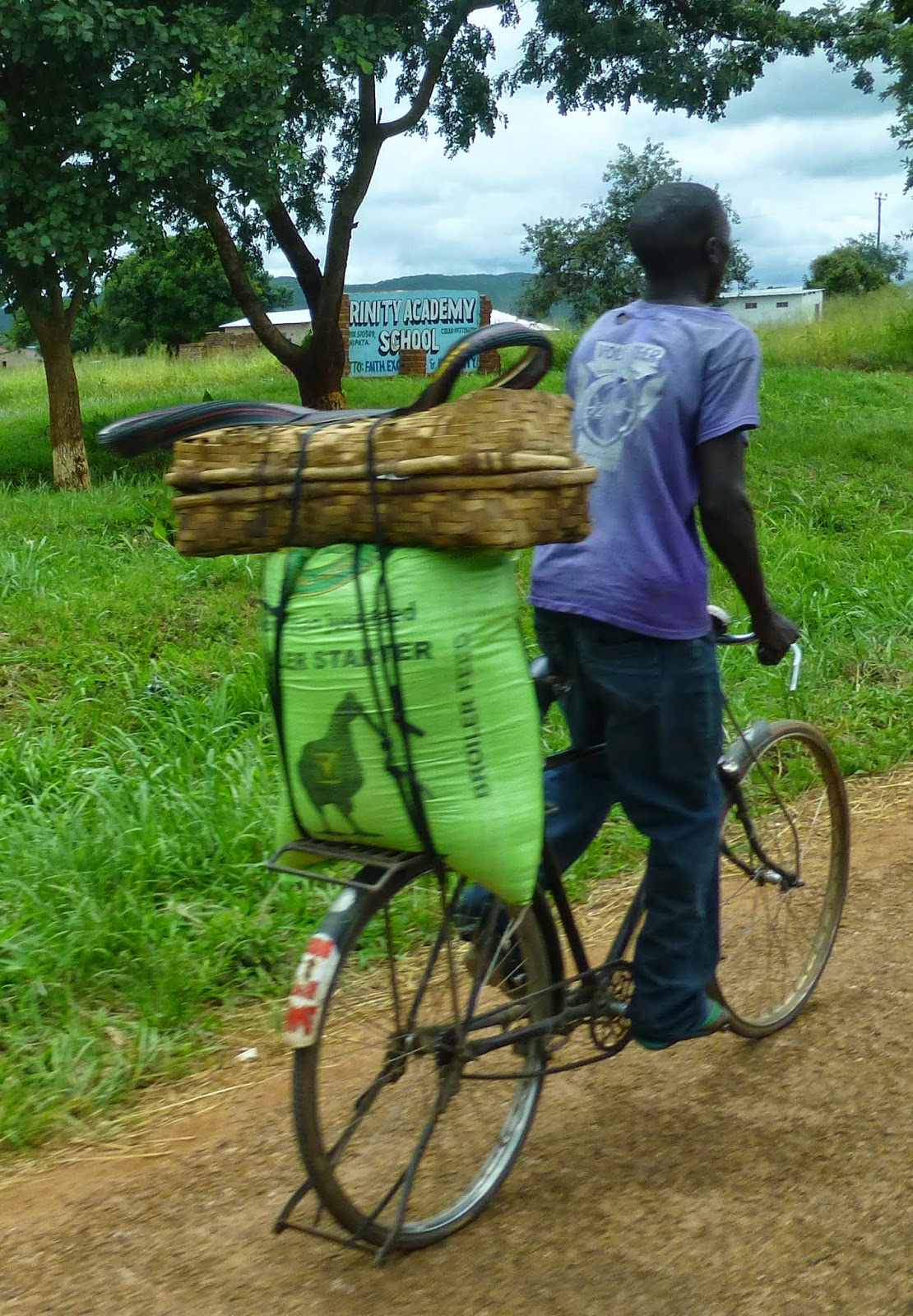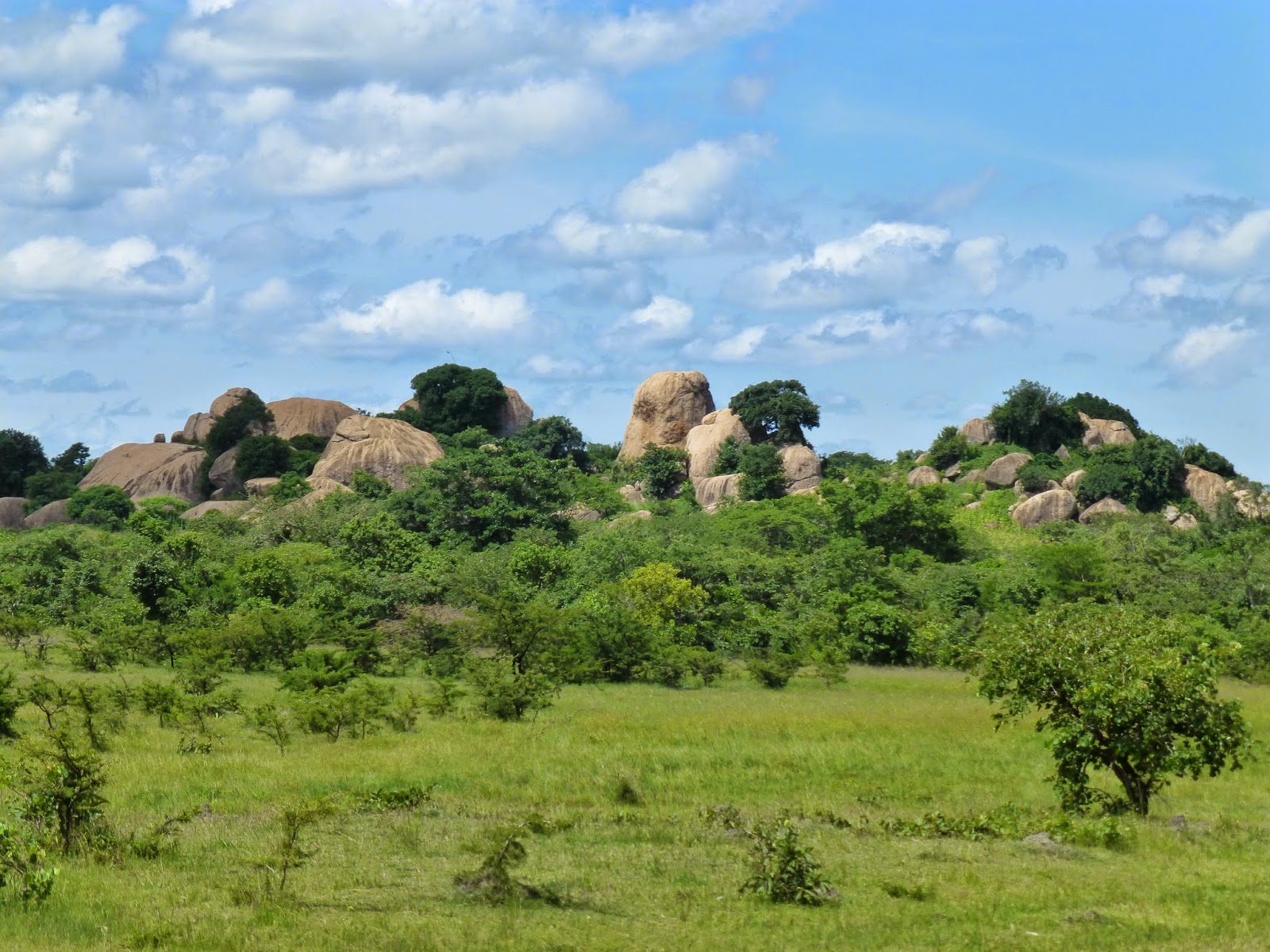Travelling 650km East opens one’s eyes to
the differences from Lusaka. I have
previously spoken about the changing terrain but what really caught my
attention was the increasing numbers of cyclists around.
 |
| Under strain peddling |
 |
| Hard work uphill |
 |
| Just keep peddling! |
I even saw two guys cycling with trussed up pigs on the back of their bikes. As we got closer to small towns or large villages there would often be a large congregation of guys with bikes under a tree. On further enquiry these are in fact the rural taxis. The bikes are equipped with a seat on the back so that they can ferry their human load to the market or back again with their wares. I’m not sure if the cost goes up with increasing BMI….
 |
| Taxi! |
Many of the women preferred walking as their main mode of transportation and used their heads to transport good though of course there were the few women that cycled, clearly wearing their colourful chitengi.
Day light proved that Chipata really was
placed in a beautiful area and it was quite a shock to wake and see myself
surrounded by mountains. Life here, even though it is a provincial captial is a
much slower pace. The markets were laden with fresh vegetables. All in season:
maize, mushrooms, ground nuts, tomatoes and pumkins.
Chipata hospital is very busy by virtue of
being the main one in the region. It also takes referrals from elsewhere which
inevitably get here very late in the course of their treatment. Dr Victor (a Ukrainian anaesthetic consultant
who has been here for 11 years and is the only doctor anaesthetist in the
province!) told me that the women are often moribund from bleeding by the time
they get here and consequently they are worried as their maternal mortality is
really high. Even St. Francis refer on to here for specialist surgery. Having
travelled along the roads yesterday it is unbelievable to me that anybody who
is unwell and cannot be dealt with at a level 1 hospital (very basic with no specialist
surgery and often no anaesthetist) is then transferred on to a level 2 hospital
– St Francis or Chipata. It is easily a three to four hour drive from St
Luke’s, an hour from St Francis but who knows how long they take to get to the
first referring hospital. The catchment is vast and they are in desperate need
of more anaesthetists to get trained and open up more theatres in this area.
Thankfully two of the clinical officers in Chipata were interns (6 months post qualifying) and they are earmarked to go and open two theatres along the Great East road once they finish in April. Good news indeed that there will be anaesthetic facilities closer to some communities, scary news in the fact that they will have completed a two year training, worked under supervision for 6 months and then be sent to not only open but run, singlehandedly a hospital theatre with no further help or supervision. One cannot say that the system mollycoddles here at all… Dr Victor was also woeful as he felt he needed to keep the two interns as they were so busy in Chipata (there are easily three or four Caesarian sections done every night). I think he’s right, they do need more man/woman power. In fact the whole country needs more anaesthetists its that simple. Thankfully the MMed programme for anaesthesia is up and running and long term will make a big difference in the country but will certainly not infiltrate the rural areas for some time (years) so the improvement in clinical officer training and more importantly post qualification refreshers and support will be vital for continued improvement in maternal health. That and improving the road infrastructure to allow people to get to hospitals quickly.
Thankfully two of the clinical officers in Chipata were interns (6 months post qualifying) and they are earmarked to go and open two theatres along the Great East road once they finish in April. Good news indeed that there will be anaesthetic facilities closer to some communities, scary news in the fact that they will have completed a two year training, worked under supervision for 6 months and then be sent to not only open but run, singlehandedly a hospital theatre with no further help or supervision. One cannot say that the system mollycoddles here at all… Dr Victor was also woeful as he felt he needed to keep the two interns as they were so busy in Chipata (there are easily three or four Caesarian sections done every night). I think he’s right, they do need more man/woman power. In fact the whole country needs more anaesthetists its that simple. Thankfully the MMed programme for anaesthesia is up and running and long term will make a big difference in the country but will certainly not infiltrate the rural areas for some time (years) so the improvement in clinical officer training and more importantly post qualification refreshers and support will be vital for continued improvement in maternal health. That and improving the road infrastructure to allow people to get to hospitals quickly.
It was a Saturday and despite all the
hustle and bustle in Chipata we were very fortunate that Freddies in Mwami
Mission hospital agreed to see us. This mission is run by the 7th Day
Adventists who do not work on a Saturday as it is a day of rest. He did,
however agree to meet us and I’m so glad he did as he is an interesting chap –
he is not a doctor nor a clinical officer. He is a nurse anaesthetist. He
trained as a nurse before heading to Tanzania for a year to learn anaesthetics
and then return. He is actually fantastic and it seems that many in the region
agree. I'm told that many apparently drive to have Freddie do their
anaesthetic for caesarians out of preference to Chipata. Maybe they don't like the wait at Chipata!
However when he then showed us into the next
theatre I noticed he also had two machines in there. This time the expensive
American machine was in the corner and one of the oldest Boyle’s machine s in
use I suspect in the world was present! It was so old it had the capacity to
give both Ether and Cyclopropane (both of which are no longer used in
anaesthesia in the UK or Zambia it seems). Despite this there was a
cyclopropane cylinder still attached to the machine. When I now enquired why he
was using such an ancient machine in preference to the new one he looked
quizzically at me and stated as if it was the most obvious thing in the world –
because its British and they were made well. Of course – echoes of Lucas at St
Francis! It seems that all the pipings in the machine are easy to access and
they are metalso he has managed to repair any fault himself, even showing me
proudly where he’d welded a bit of piping. I point out that next time it might
be wise to remove the cyclopropane cylinder first (highly flammable!). Gulp!
 |
| Wisdom and Freddies in theatre. Expensive American machine to the side and British built Boyles in use! |
 |
| Eastern province rock formations |









Hi Lowri, good to read about your experiences in Zambia. Sorry to hear that the Glostaven anaesthetic machine at Mwami Mission Hospital no longer has its ventilator. It certainly had one when we sent it out there in 2008, I wonder what happened to it? If there any chance you could send us a photo of it, we could see what is missing. When you are back in the UK you are most welcome to visit us in north Devon for some handson demonstrations of our range of medical equipment for low resource settings. Contact us at info@diamedica.co.uk
ReplyDelete